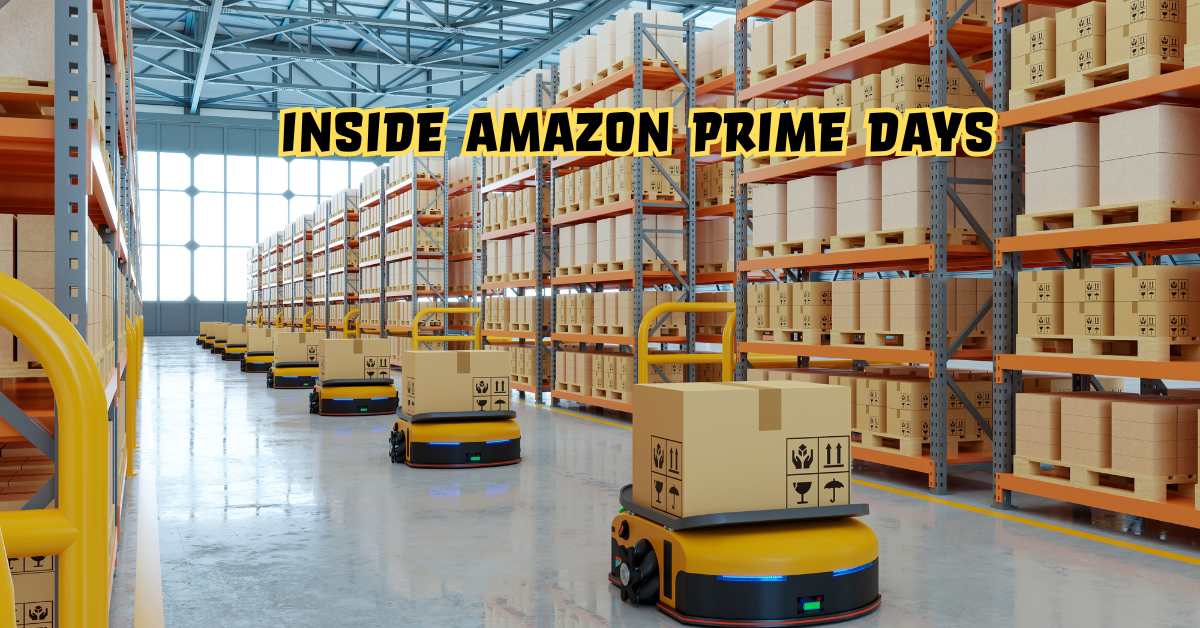Amazon Prime Days have become far more than a retail event—they are a global phenomenon that redefines how consumers shop, how brands compete, and how the digital economy functions. For millions of shoppers, Amazon Prime Days mark a time to secure massive deals across electronics, home goods, fashion, and services. For retailers, it represents a high-stakes competition for consumer attention. For economists, it’s an annual insight into shifting purchasing behavior and online retail dominance.
In the first 100 words, let’s address the core of your curiosity: Amazon Prime Days are special promotional events exclusively for Amazon Prime members, offering limited-time discounts across product categories. But beneath the excitement of shopping lies a deeper narrative about data-driven marketing, global logistics, pricing psychology, and consumer loyalty. This article explores how Prime Days began, their economic scale, marketing evolution, and cultural impact—along with what makes them one of the most studied retail strategies in the world today.
Spanning continents, Prime Days now influence how other e-commerce giants plan their own sales, how traditional retailers respond, and how shoppers manage their annual budgets. Amazon uses these days not just for sales, but as a testing ground for algorithms, delivery systems, and subscription engagement. The event has turned into a digital festival—part entertainment, part commerce, and part social trend.
The Origins and Evolution of Amazon Prime Days
When Amazon first launched Prime in 2005, it was merely a membership offering faster shipping. The introduction of Prime Days in 2015 changed everything. Conceived to celebrate Amazon’s 20th anniversary, the inaugural event was a one-day sale offering exclusive deals for Prime subscribers. Though the first iteration faced technical glitches and mixed reviews, it sparked an evolution in retail timing, setting the stage for what would become an annual retail tradition rivaling even Black Friday and Cyber Monday.
The idea behind Prime Days was not just to drive immediate revenue but to strengthen the Prime ecosystem. Amazon’s executives recognized that shoppers who joined Prime were significantly more likely to remain long-term customers. Prime Days thus became a magnet to both attract new members and remind existing ones of the tangible benefits of their subscription.
As years progressed, the event extended from a single day to multiple days—often spanning 48 hours or more. Global markets joined in, transforming Prime Days into a synchronized shopping moment across North America, Europe, and Asia. Each year, new product launches, brand partnerships, and exclusive entertainment tie-ins expanded its cultural significance. By 2025, Prime Days are not just sales—they are a statement of Amazon’s technological and economic reach.
The Strategic Purpose Behind Prime Days
To truly understand Amazon Prime Days, one must go beyond discounts and delivery. The event is a multifaceted strategy encompassing marketing, logistics, subscription retention, and data analytics.
1. Boosting Prime Membership
Amazon uses Prime Days to drive new memberships by offering special sign-up bonuses or exclusive perks for new users. Once inside the ecosystem, customers benefit from streaming, cloud storage, and discounts—creating long-term loyalty.
2. Data Harvesting and Behavioral Insight
Every click, search, and cart addition during Prime Days feeds Amazon’s data engine. These insights refine recommendation algorithms, predict future trends, and enhance personalization for every user.
3. Inventory Management
Prime Days serve as an effective inventory-balancing mechanism. Amazon clears overstocked items while promoting new releases, optimizing warehouse efficiency before the holiday season.
4. Vendor Relations and Brand Testing
For brands, Prime Days offer an unmatched platform to measure market response. New products often debut here, allowing Amazon and vendors to gauge consumer reaction almost instantly.
5. Psychological Engagement
Scarcity and urgency—limited-time deals, countdown timers, lightning offers—are embedded into the user experience, driving emotional engagement. Prime Days tap into consumer psychology as much as economics.
This strategic interplay transforms Prime Days into a masterclass in modern retail innovation, where technology and human behavior intersect.
Global Economic Impact of Amazon Prime Days
Amazon Prime Days are not confined to screens—they ripple through global markets, logistics networks, and even labor systems. The economic footprint of this event reveals how deeply interconnected modern e-commerce has become.
| Year | Duration (Days) | Estimated Sales (USD Billions) | New Prime Members (Millions) | Top Product Category Sold |
|---|---|---|---|---|
| 2015 | 1 | 0.9 | 1.1 | Electronics |
| 2018 | 2 | 4.2 | 3.5 | Smart Home Devices |
| 2020 | 2 | 10.4 | 5.0 | Household Essentials |
| 2022 | 2 | 12.5 | 6.1 | Wearables & Tech Gadgets |
| 2024 | 2 | 14.8 | 6.8 | Smart TVs & Appliances |
The table highlights the consistent growth of Prime Days—sales doubling every few years while the number of new Prime members continues to climb.
Beyond raw figures, the impact reaches further: logistics companies experience spikes in demand, small and medium-sized sellers achieve record exposure, and global manufacturing responds to heightened seasonal demand. It demonstrates how a corporate event can influence macroeconomic indicators, from consumer spending trends to shipping rates.
The Role of Artificial Intelligence and Logistics
One of Amazon’s greatest achievements lies in seamlessly coordinating massive global logistics with AI-driven precision. During Prime Days, millions of products move through automated warehouses, guided by algorithms that anticipate regional demand.
AI systems predict which items are most likely to sell in specific zip codes, pre-positioning them in fulfillment centers before the event even begins. Machine learning models analyze weather patterns, traffic congestion, and consumer sentiment to streamline last-mile delivery.
Additionally, Amazon’s “anticipatory shipping” concept—a predictive logistics innovation—prepares shipments before customers even complete their orders, minimizing delays. This technology infrastructure forms the invisible backbone of Prime Days, ensuring the promise of two-day delivery (or even same-day delivery in some regions) is met despite the massive surge in volume.
Such precision logistics, powered by data, illustrate why Prime Days are as much a technology demonstration as a shopping spree.
The Psychological Playbook: How Amazon Shapes Shopping Behavior
The secret to Amazon Prime Days’ success lies in psychological design—the art of nudging customers toward faster and larger purchases. Behavioral economics drives much of the event’s architecture.
- Urgency & Scarcity: Limited-time lightning deals create a sense of scarcity, prompting immediate decisions.
- Anchoring Effect: Amazon displays the “original” price next to the discounted one, making savings appear more significant.
- Social Proof: Seeing products labeled as “best sellers” or “most purchased” reassures buyers.
- Gamification: Prime Days often feature interactive challenges—watching videos, exploring new categories—to earn small credits.
- Emotional Anchors: Amazon’s design language—color-coded deal badges, countdown visuals—triggers excitement and anticipation.
The brilliance lies in balancing satisfaction and stimulation. As one marketing expert aptly put it:
“Prime Days aren’t about discounts; they’re about dopamine.”
Amazon has turned shopping into a digital sport, where every deal feels like a personal victory.
Prime Days and Competing Retailers
Prime Days have forced competitors to rethink their own retail calendars. Walmart, Target, and Best Buy now host simultaneous sales to counter Amazon’s gravitational pull. These “anti-Prime Day” events mark a significant shift in the retail power dynamic.
Traditional retailers, once bound by in-store promotions, have adopted the digital-first urgency pioneered by Amazon. This has intensified price competition, spurred faster shipping innovations, and elevated online advertising budgets.
Interestingly, smaller retailers benefit indirectly as well. Increased consumer awareness during Prime Days often spills over to independent e-commerce stores, driving traffic even outside Amazon’s ecosystem.
In essence, Amazon’s move catalyzed a ripple effect that permanently altered how the retail calendar operates worldwide.
Environmental and Ethical Considerations
Amidst the excitement, Amazon Prime Days also invite criticism and ethical reflection. The massive surge in sales increases packaging waste, carbon emissions, and labor strain. Critics argue that the “buy now” culture perpetuated by such events fuels overconsumption and unsustainable manufacturing.
Amazon, in response, has expanded sustainability initiatives—investing in renewable energy, introducing “Frustration-Free Packaging,” and pledging net-zero carbon by 2040. However, challenges persist, especially regarding warehouse working conditions during peak demand.
Balancing commercial growth with environmental responsibility remains one of the defining dilemmas of the modern retail age. As one analyst remarked:
“Prime Days reveal not only what we buy, but what it costs the planet.”
The future of Prime Days will depend as much on sustainability efforts as on innovation and convenience.
Prime Days in the Age of Globalization
Prime Days are no longer confined to the U.S. market. Countries from India to Germany, Japan to Australia, have integrated localized versions, tailored to regional consumer habits.
Localization involves adjusting prices, featuring domestic sellers, and timing events to align with regional festivities. For instance, in some Asian markets, Prime Days overlap with cultural holidays to maximize participation.
This global expansion demonstrates how Amazon blends global strategy with local nuance—ensuring cultural relevance while maintaining brand uniformity.
The worldwide synchronization also underscores Amazon’s logistical mastery: thousands of warehouses, millions of products, and billions in transactions occurring almost simultaneously.
Cultural Impact: The Festivalization of Shopping
Amazon Prime Days have transformed online retail into an event-driven culture. Shopping, once a utilitarian act, has become a digital celebration. Social media amplifies this transformation—users share “haul videos,” influencers curate “Prime Picks,” and hashtags trend for days.
This cultural shift has implications beyond commerce. It mirrors how digital experiences increasingly substitute for traditional social interactions. Shopping is no longer solitary; it’s communal, performative, and entertainment-driven.
The “festivalization” of Prime Days also indicates how Amazon positions itself not merely as a retailer but as a cultural force, blending e-commerce with lifestyle and entertainment.
How Prime Days Redefine Consumer Expectations
Prime Days have permanently altered consumer expectations regarding pricing, delivery, and digital experience. Shoppers now anticipate similar discounts year-round, forcing retailers to maintain competitive pricing strategies.
Moreover, fast shipping—once a luxury—is now considered a baseline service. Consumers have been conditioned to expect two-day, or even same-day, deliveries regardless of product or seller.
This “expectation inflation” has reshaped logistics industries globally, leading to increased automation, micro-warehousing, and AI-driven delivery optimization.
The broader impact extends into trust and loyalty: customers who experience seamless transactions during Prime Days tend to view Amazon as the default retail platform.
Statistical Snapshot: Key Insights from Amazon Prime Days
| Indicator | Insight |
|---|---|
| Average Order Value | $110 per customer |
| Most Purchased Category | Electronics & Home Essentials |
| Fastest Selling Item | Smart Speakers (Under 2 hours) |
| Mobile Shopping Share | 65% of total transactions |
| Countries Participating | Over 20 |
| Average Discount Range | 20–60% |
| Customer Satisfaction Rate | 91% |
These figures highlight not only the scale but also the diversity of consumer engagement—demonstrating how Prime Days merge accessibility with personalization.
The Role of Entertainment and Streaming Integration
In recent years, Amazon has integrated its entertainment platforms—Prime Video and Twitch—into Prime Days. Livestream shopping events, celebrity appearances, and music performances create immersive experiences.
Such integrations blur the lines between commerce and content. Viewers can watch exclusive performances while shopping in real-time. This fusion transforms the Prime membership into a lifestyle ecosystem where entertainment and shopping coexist.
By merging retail and media, Amazon reinforces its dominance in both sectors—establishing Prime Days as a hybrid cultural and commercial event.
The Future of Prime Days: Predictions for the Next Decade
Looking ahead, the next decade of Prime Days will be defined by technological advancement, sustainability, and personalization.
- Hyper-Personalized Deals
AI will tailor offers uniquely for each user, adjusting prices dynamically based on past behavior. - Virtual Reality Shopping
Immersive environments could allow users to “walk” through virtual Amazon stores during Prime Days. - Sustainable Logistics Networks
Amazon’s renewable energy fleets and carbon-neutral packaging will become integral to the brand narrative. - Micro-Prime Events
Smaller, localized Prime Days may emerge to maintain year-round engagement. - AI-Enhanced Live Shopping
Influencer-led, real-time deal streams could become a norm, merging entertainment with immediacy.
Prime Days are no longer about selling products—they are about reinventing commerce itself.
Voices of the Marketplace
To grasp the emotional dimension, one must listen to the voices of participants:
“Prime Days feel like a game—you’re chasing deals, competing with time.” – Customer, London
“We plan months in advance. It’s not just a sale; it’s our Super Bowl.” – Seller, California
These perspectives highlight the multi-dimensional nature of Prime Days—a moment of excitement, stress, and innovation all at once.
Five Frequently Asked Questions (FAQs)
1. What is the main purpose of Amazon Prime Days?
Prime Days are designed to boost Amazon Prime memberships, drive large-scale sales, test logistics efficiency, and collect consumer data insights for future marketing strategies.
2. How often do Amazon Prime Days occur?
Typically once a year, though Amazon occasionally hosts additional “Prime Big Deal Days” during fall as a secondary shopping event.
3. Are deals truly exclusive to Prime members?
Yes, most offers are accessible only to Prime members, encouraging new sign-ups and emphasizing loyalty benefits.
4. Do third-party sellers benefit equally during Prime Days?
While visibility increases, competition is intense. Sellers with optimized listings and fulfillment by Amazon (FBA) tend to perform best.
5. How do Amazon Prime Days influence other retailers?
Competitors such as Walmart and Target often launch simultaneous events to retain market share, reshaping the entire retail calendar.
Conclusion
Amazon Prime Days have evolved from a one-day celebration into a global economic force, shaping not just e-commerce but the culture of consumption itself. It is a masterclass in how technology, psychology, and logistics converge to redefine shopping experiences.
What began as a loyalty initiative has become a pulse of modern consumer behavior—a showcase of innovation, ambition, and adaptability. The event mirrors our era’s dualities: convenience and complexity, excitement and excess, opportunity and overconsumption.
As the world becomes more digitized, Amazon’s annual shopping festival offers a glimpse into the future of retail—where personalization replaces promotion, where data fuels decision-making, and where commerce becomes a cultural event. Prime Days have already changed how we buy; soon, they may change how we think about buying itself.











